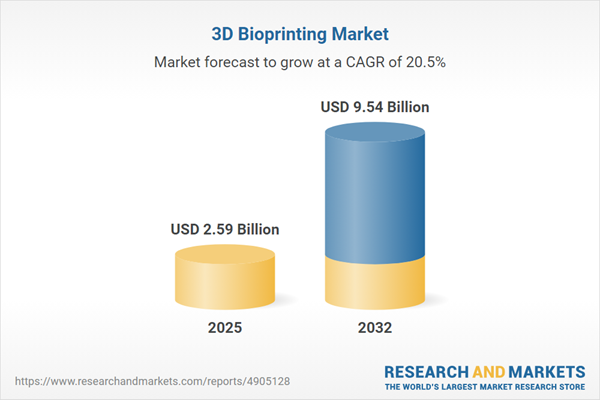Speak directly to the analyst to clarify any post sales queries you may have.
The 3D bioprinting market is entering a new phase of high-growth and innovation, driven by its applications in healthcare, biotechnology, and research. This technology is rapidly expanding its influence on clinical and commercial processes, unlocking new potential for stakeholders across global markets.
Market Snapshot: 3D Bioprinting Market Size and Growth
The 3D bioprinting market grew from USD 2.14 billion in 2024 to USD 2.59 billion in 2025. With an expected CAGR of 20.50%, projections show the market will reach USD 9.54 billion by 2032. This robust trajectory reflects rapid adoption in regenerative medicine, advancements in pharmaceutical research, and industry-wide adoption of next-generation biofabrication methods. Strategic investments and technological progress are strengthening the sector’s position across the Americas, Europe, Middle East, Africa, and Asia-Pacific, marking 3D bioprinting as a pivotal segment within the broader healthcare and life sciences landscape.
Scope & Segmentation of the 3D Bioprinting Market
This report delivers in-depth coverage of market segmentation, providing stakeholders with actionable context for strategic decisions. The primary segments include:
- Application Areas: Cosmetics and personal medicine, drug discovery and testing, organ printing, tissue engineering
- Technologies: Extrusion (piston, pneumatic, screw-based), inkjet (piezoelectric, thermal), laser-assisted (forward transfer), stereolithography (conventional, digital light processing)
- Material Types: Composite bioinks, decellularized ECM, hydrogels (natural, synthetic), synthetic polymers (PCL, PLA, PLGA)
- End Users: Academic institutions, hospitals and clinics, pharmaceutical and biotechnology companies, research institutes (government centers, private labs)
- Tissue Types: Cartilage, hard tissue (bone, dental), neural tissue, soft tissue (muscle, skin), vascular tissue
- Regions and Countries: Americas (United States, Canada, Latin America), Europe (United Kingdom, Germany, France, and others), Middle East (UAE, Saudi Arabia, and others), Africa (South Africa, Nigeria), Asia-Pacific (China, India, Japan, Australia, and others)
- Companies Tracked: 3D Systems, Organovo Holdings, BICO AB, Desktop Metal, CollPlant Biotechnologies, RegenHU, Aspect Biosystems, Poietis, Cyfuse Biomedical, Advanced Solutions Life Sciences
Key Takeaways for Senior Decision-Makers
- Market growth is underpinned by the integration of advanced printing platforms and evolving bioink formulations, which are expanding the feasibility of clinical and research applications.
- Adoption rates vary by region, with Asia-Pacific showing strong government support and manufacturing scale, while the Americas benefit from established regulatory and funding environments.
- Strategic alliances between technology developers, healthcare institutions, and research organizations are accelerating innovation cycles and validating new product lines.
- Material diversification is mitigating supply chain risks and fostering competition among local and international suppliers, enhancing market resilience.
- Demand is rising for modular, interoperable platforms that can support a spectrum of biological materials and integrate with advanced imaging or analytics tools.
Tariff Impact: Navigating Supply Chain Shifts and Regional Investments
Recent United States tariffs on biopolymers and specialty reagents have driven up input costs for manufacturers and research users that depend on imported materials. In response, many organizations are restructuring sourcing strategies, investing in domestic bioink developments, and forging regional supply agreements. These shifts are not only tempering short-term disruptions but also nurturing local capabilities and competitive manufacturing ecosystems in the 3D bioprinting space.
Methodology & Data Sources
This research employs a rigorous mixed-methods approach. Comprehensive secondary research analyzed scientific publications, patents, and regulatory filings, paired with direct interviews of industry leaders and surveys of end users. Data triangulation and validation through multiple independent sources ensure reliable insights across quantitative market trends and qualitative business perspectives.
The Value of In-Depth 3D Bioprinting Market Research
- Gain strategic intelligence on emerging applications, technology adoption, and supply chain innovations across diverse global regions.
- Optimize investments and partnerships by leveraging competitive profiles and proven methodologies for market forecasting and risk assessment.
Conclusion
As 3D bioprinting matures, organizations that invest in adaptable technologies and long-term regional strategies are best positioned to capture emerging opportunities. This report enables stakeholders to make informed, strategic decisions in a market defined by rapid progress and dynamic, cross-disciplinary innovation.
Additional Product Information:
- Purchase of this report includes 1 year online access with quarterly updates.
- This report can be updated on request. Please contact our Customer Experience team using the Ask a Question widget on our website.
Table of Contents
3. Executive Summary
4. Market Overview
7. Cumulative Impact of Artificial Intelligence 2025
Companies Mentioned
The companies profiled in this 3D Bioprinting market report include:- 3D Systems, Inc.
- Organovo Holdings, Inc.
- BICO AB
- Desktop Metal, Inc.
- CollPlant Biotechnologies Ltd.
- RegenHU Ltd.
- Aspect Biosystems Inc.
- Poietis SAS
- Cyfuse Biomedical K.K.
- Advanced Solutions Life Sciences LLC
Table Information
| Report Attribute | Details |
|---|---|
| No. of Pages | 192 |
| Published | November 2025 |
| Forecast Period | 2025 - 2032 |
| Estimated Market Value ( USD | $ 2.59 Billion |
| Forecasted Market Value ( USD | $ 9.54 Billion |
| Compound Annual Growth Rate | 20.5% |
| Regions Covered | Global |
| No. of Companies Mentioned | 11 |









